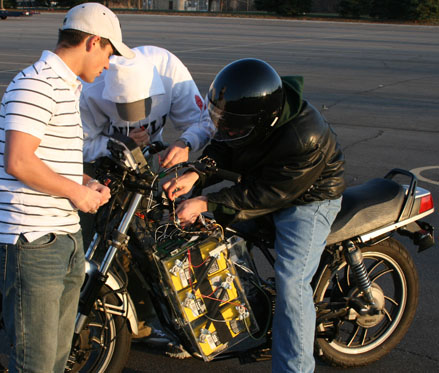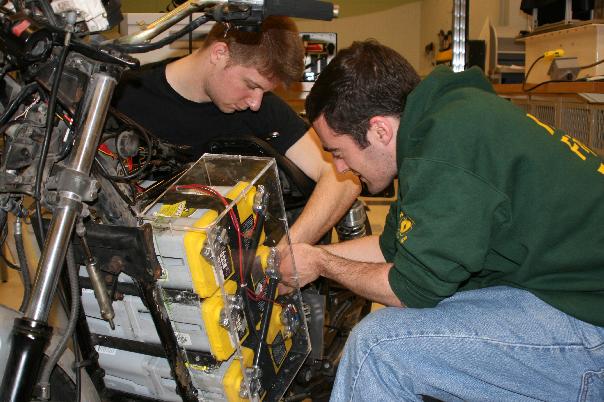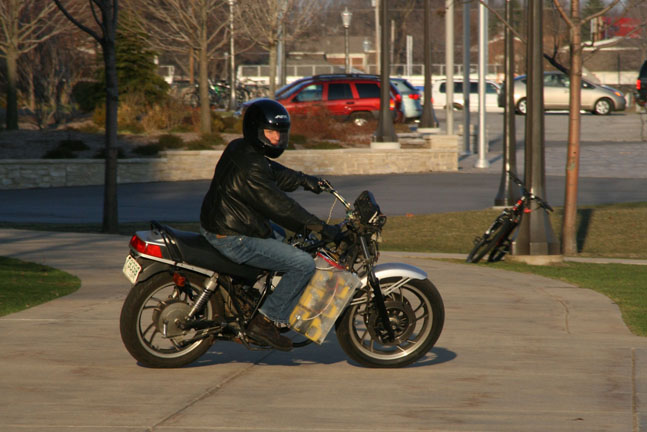working together to build a hybrid electric vehicle.
History
In the spring of 2007, four of the five members of our team (John Sember, Vincent Cano, Stephen Govea and Brian Bak) took a course at Notre Dame entitled Electric and Hybrid Vehicles. The class provided a basic overview of the current technologies surrounding internal combustion (IC) engine vehicles, their environmental impacts, as well as alternative means of propulsion in vehicles, such as electric and hybrid propulsion systems. While taking the course, several of them expressed their interest in the possibility of building an electric/hybrid vehicle of some sort for the following year's senior design project. The idea was solidified over the summer after consultation with Notre Dame's Energy Center for funding of the project. John Mrugala was added to the team the following fall semester during our senior design course.
a basic overview of the current technologies surrounding internal combustion (IC) engine vehicles, their environmental impacts, as well as alternative means of propulsion in vehicles, such as electric and hybrid propulsion systems. While taking the course, several of them expressed their interest in the possibility of building an electric/hybrid vehicle of some sort for the following year's senior design project. The idea was solidified over the summer after consultation with Notre Dame's Energy Center for funding of the project. John Mrugala was added to the team the following fall semester during our senior design course.
Armed with several models and simulations of hybrid vehicle performance characteristics, our team analyzed possible design requirements for a car, dune buggy and motorcycle. We eventually decided on the motorcycle base because it would require the least amount of time, money and additional mechanical knowledge to construct. We were able to propose several key benchmarks which our prototype motorcycle could reasonably achieve. While a motorcycle is overall lighter and requires much smaller components than a car, it also has weight and size constraints, as well as the unique problem of balancing. We used the simulations as well as a donated motorcycle chassis to design a conceptual series hybrid motorcycle, the details of which can be found in the Documentation section.
About Us
The Lightning Riders Team is composed of five senior electrical engineers at the University of Notre Dame (see the Team link above). We are now in the second semester of a two-semester Senior Design course in the Electrical Engineering department. The Senior Design course is designed to provide electrical engineering seniors with the opportunity to use the technical expertise they have acquired while at Notre Dame and apply it to a capstone project of their choosing. We are given a great deal of flexibility when selecting a project, provided the scope of the project was achievable in one year's time. Our project is funded in part through the EE department, but our primary sponsors can be found on our Sponsors page.
second semester of a two-semester Senior Design course in the Electrical Engineering department. The Senior Design course is designed to provide electrical engineering seniors with the opportunity to use the technical expertise they have acquired while at Notre Dame and apply it to a capstone project of their choosing. We are given a great deal of flexibility when selecting a project, provided the scope of the project was achievable in one year's time. Our project is funded in part through the EE department, but our primary sponsors can be found on our Sponsors page.
The fall semester was spent creating a theoretical design for the motorcycle and working through various challenges; please see our Documentation section for the primary documentation from the fall. During the spring semester we are making the design a reality and putting the pieces together. As our project moves forward, we will be placing updates on this site as they become available.
The base motorcycle we are converting for this project is a 1983 Yamaha Seca, which was donated to the team. It, and one of our members, John Sember, is featured below.
In the spring of 2007, four of the five members of our team (John Sember, Vincent Cano, Stephen Govea and Brian Bak) took a course at Notre Dame entitled Electric and Hybrid Vehicles. The class provided
 a basic overview of the current technologies surrounding internal combustion (IC) engine vehicles, their environmental impacts, as well as alternative means of propulsion in vehicles, such as electric and hybrid propulsion systems. While taking the course, several of them expressed their interest in the possibility of building an electric/hybrid vehicle of some sort for the following year's senior design project. The idea was solidified over the summer after consultation with Notre Dame's Energy Center for funding of the project. John Mrugala was added to the team the following fall semester during our senior design course.
a basic overview of the current technologies surrounding internal combustion (IC) engine vehicles, their environmental impacts, as well as alternative means of propulsion in vehicles, such as electric and hybrid propulsion systems. While taking the course, several of them expressed their interest in the possibility of building an electric/hybrid vehicle of some sort for the following year's senior design project. The idea was solidified over the summer after consultation with Notre Dame's Energy Center for funding of the project. John Mrugala was added to the team the following fall semester during our senior design course.
Armed with several models and simulations of hybrid vehicle performance characteristics, our team analyzed possible design requirements for a car, dune buggy and motorcycle. We eventually decided on the motorcycle base because it would require the least amount of time, money and additional mechanical knowledge to construct. We were able to propose several key benchmarks which our prototype motorcycle could reasonably achieve. While a motorcycle is overall lighter and requires much smaller components than a car, it also has weight and size constraints, as well as the unique problem of balancing. We used the simulations as well as a donated motorcycle chassis to design a conceptual series hybrid motorcycle, the details of which can be found in the Documentation section.
About Us
The Lightning Riders Team is composed of five senior electrical engineers at the University of Notre Dame (see the Team link above). We are now in the
 second semester of a two-semester Senior Design course in the Electrical Engineering department. The Senior Design course is designed to provide electrical engineering seniors with the opportunity to use the technical expertise they have acquired while at Notre Dame and apply it to a capstone project of their choosing. We are given a great deal of flexibility when selecting a project, provided the scope of the project was achievable in one year's time. Our project is funded in part through the EE department, but our primary sponsors can be found on our Sponsors page.
second semester of a two-semester Senior Design course in the Electrical Engineering department. The Senior Design course is designed to provide electrical engineering seniors with the opportunity to use the technical expertise they have acquired while at Notre Dame and apply it to a capstone project of their choosing. We are given a great deal of flexibility when selecting a project, provided the scope of the project was achievable in one year's time. Our project is funded in part through the EE department, but our primary sponsors can be found on our Sponsors page.
The fall semester was spent creating a theoretical design for the motorcycle and working through various challenges; please see our Documentation section for the primary documentation from the fall. During the spring semester we are making the design a reality and putting the pieces together. As our project moves forward, we will be placing updates on this site as they become available.
The base motorcycle we are converting for this project is a 1983 Yamaha Seca, which was donated to the team. It, and one of our members, John Sember, is featured below.

